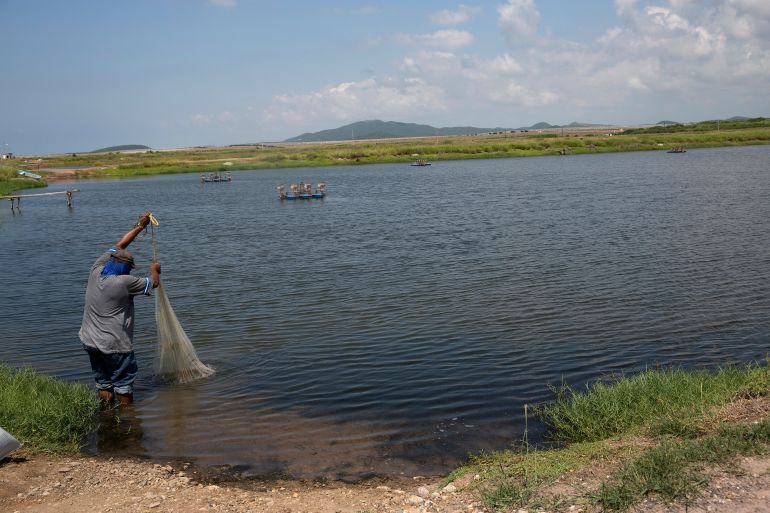To address malnutrition, we should turn to ‘blue’ foods
A ‘blue food revolution’ can help turn the tide against climate change and malnutrition.

Our food system currently leaves three billion malnourished and will have to feed 10 billion people by 2050, all under the intensifying and unpredictable effects of climate change.
Aquatic “blue” foods – fish, shellfish and algae that are caught or cultivated in fresh or saltwater – are poised to play an ever more important role in addressing this gap and building a better food system in the future.
Keep reading
list of 4 itemsAt least 155 killed in Tanzania as heavy rains pound East Africa
Scientists say Oman, UAE deluge ‘most likely’ linked to climate change
Photos: Deadly floods wreak havoc in Kenya’s capital
A landmark new study, the Blue Food Assessment (BFA), shows how we can benefit from the multitude of opportunities that exist in the world’s waters.
With demand for aquatic foods already predicted to nearly double by 2050, researchers found that expanding blue food production even further could make a big difference for public health. Their models indicate that an additional increase of 8 percent in supply would drive down blue food prices, making it easier for poorer households to buy and eat and preventing an estimated 166 million cases of malnutrition around the world as a result. What’s more, in three out of four countries, these benefits accrued even more so to women.
To make the most of this rising demand, however, improvements are urgently needed to drive the sector towards greater efficiency, sustainability and equity. Here’s what we need to do to make the most of that potential, and truly begin to turn the tide against the global challenges of climate change and malnutrition.
First, we need to recognise that blue foods are important foods. The policies and programmes that shape our food systems have long focused on agriculture, leaving blue foods on the sidelines. Blue foods already provide vital nutrition to more than three billion people – and they can play an even more essential role in meeting the challenges that lie ahead.
Second, we must capitalise on the incredible diversity of blue foods. We eat more than 2,500 different aquatic species. They vary hugely in the nutrients they provide. Small pelagic fish such as anchovies and sardines, for example, have approximately eight times more iron, five times more omega-3 fatty acids, and four times more vitamin B-12 than tilapia (a commonly eaten white fish).
Blue food production systems also vary widely in their environmental footprints – bottom trawling can have very high greenhouse gas emissions; cultivation of bivalves and seaweed, on the other hand, can actually be carbon-negative.
Our research shows that embracing this rich diversity offers rich opportunities to meet our many needs and tastes and to find paths that allow us to meet multiple goals at once – to have foods that offer higher nutrition, lower environmental footprints, and more equitable livelihoods.
That means driving better practices in many parts of the sector. More fundamentally, it also means expanding our blue food horizons – eating more diverse species of fish, like sardines and anchovies instead of just salmon, and further branching out into other foods like oysters, mussels and seaweeds.
Third, we must recognise and support the vital role of small-scale producers in the blue food sector. Small-scale actors produce, process, and sell most of the blue foods that are destined for human consumption, while providing livelihoods and security for hundreds of millions worldwide.
Yet, these actors are often neglected by policymakers and by markets, which tend to focus on large, industrial producers. Small-scale actors must have a seat at the table in managing blue food resources. And they need support – including infrastructure, such as cold chains, that allow them to access markets; finance for innovation and the sustainable intensification of production; and cooperatives that allow small actors to access national and international markets.
Finally, like other food systems, blue food systems will be disrupted by climate change. The blue food sector needs to do its part to reduce emissions – better fisheries management, for example, can lower emissions because fishers can catch their quota with less time on the water. We must also invest in climate resilience. Our research shows that the countries and communities that are most dependent on blue food consumption are also most exposed to climate risks and least prepared to cope with them. Even if the world achieves the Paris goals for controlling emissions, more than 50 countries will face high climate risk due to high dependence on blue food benefits and high vulnerability to loss of those benefits.
With nine fishing seasons left to achieve the 2030 Sustainable Development Goals, the research shows that blue foods are one of the best solutions to the dual challenges of climate change and malnutrition that are rapidly accelerating around the world.
Ultimately, we can begin to turn the tide against these global challenges, but only if we unlock and unleash the vast potential of blue foods.
The views expressed in this article are the author’s own and do not necessarily reflect Al Jazeera’s editorial stance.
